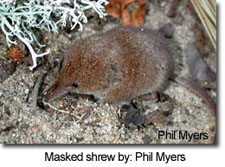
Masked Shrew
Sorex cinereus
Description & Range:
The masked shrew is a small species of shrew that is 8-11 cm total in length, with a long tail that is 3-5 cm. They have tiny eyes, small ears that are completely covered by fur, and a long, pointed snout. Their fur is short and velvety, grayish-brown on the upper side of its body, and lighter underneath. One distinctive feature is a bicolored tail, which is dark above and pale below.
The masked shrew has the largest range of any North American shrew and wide geographic variation. They can be found throughout Alaska, Canada, the northern third of the United States, and portions of the Great Basin, Rockies, and Appalachians. They have been documented in a majority of Maryland counties, though insufficient data exists to conclusively determine their population density.
Habitat:
The masked shrew is a habitat generalist throughout most of its range. Soil moisture, organic matter, and understory vegetation are the most important factors that influence local distribution and abundance. Leaf litter, fallen logs, rocks, stumps, and other structures are also essential in providing cover.
Diet:
Due to the masked shrew’s small size, they primarily eat prey items less than 10 mm in length. They are a food generalist, eating mostly insects, centipedes, spiders, and earthworms. Occasionally, they will kill and eat small animals like salamanders and nesting birds. The masked shrew requires large quantities of food, and can eat up three times its body weight every day.
Reproduction:
The breeding season occurs from April through October. There is typically one litter born in the spring and another in the fall, with up to ten young produced per litter. They make spherical nests out of leaves and grasses that are located under logs, rocks, and tree stumps.
Sounds:
The masked shrew produces a variety of vocalizations. When defensive, they will make staccato squeaks. During foraging they will produce “faint twitters”, and teeth “gritting” while resting.
Behavior:
Masked shrews are nocturnal and are the most active from 1-2 a.m. Their primary activity is hunting, and they are able to run quickly and jump 10-15 cm high. They have an excellent sense of smell, using their whiskers to find their way around and detect prey. They construct burrows underneath leafy cover and debris, and they will also utilize the burrows of other small mammals opportunistically.
Sources: